| Published in Attractions / Places of Interest |
Gran Paradiso National Park, Italy
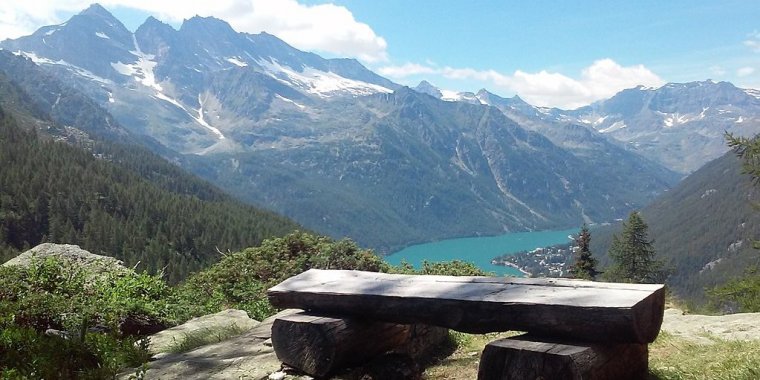
Parco nazionale del Gran Paradiso. ![]()
Gran Paradiso National Park (Italian: Parco nazionale del Gran Paradiso, French: Parc national du Grand Paradis), is an Italian national park in the Graian Alps, between the Aosta Valley and Piedmont regions. The park is named after Gran Paradiso mountain, which is located in the park, and is contiguous with the French Vanoise national park.
The land the park encompasses was initially protected in order to protect the Alpine ibex from poachers, as it was a personal hunting ground for king Victor Emmanuel II, but now also protects other species.
The park is located in the Graian Alps in the regions of Piedmont (in the Metropolitan City of Turin) and Aosta Valley in north-west Italy. It encompasses 703 square kilometres (173,715 acres) of alpine terrain. 10% of the park's surface area is wooded. 16.5% is used for agriculture and pasture, 24% is uncultivated, and 40% is classified as sterile. 9.5% of the park's surface area is occupied by 57 glaciers.
The park's mountains and valleys were sculpted by glaciers and streams. Altitudes in the park range from 800-4,061 metres (2,624-13,323 ft), with an average altitude of 2,000 metres (6,561 ft).
Valley floors in the park are forested. There are alpine meadows at higher altitudes. There are rocks and glaciers at altitudes higher than the meadows. Gran Paradiso is the only mountain entirely within the boundaries of Italy that is over 4,000 metres (13,123 ft) high. Mont Blanc and the Matterhorn can be seen from its summit.
In 1860, John Cowell became the first person to reach the summit. To the west, the park shares a boundary with France's Vanoise National Park. They co-operate in managing the ibex population, which moves across their shared boundary seasonally.
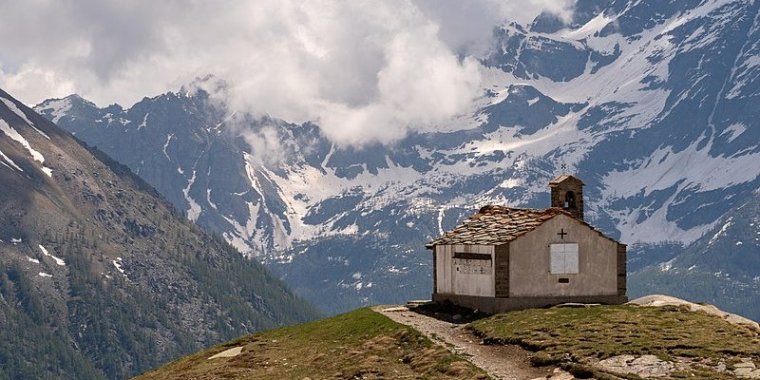
Parco nazionale del Gran Paradiso. ![]()
The park's woods are important because they provide shelter for a large number of animals. They are a natural defence against landslides, avalanches, and flooding. The two main types of woods found in the park are coniferous and deciduous woods. The deciduous European beech forests are common on the Piedmont side of the park, and are not found on the dryer Valle d'Aosta side.
These forests are thick with dense foliage that lets in very little light during the summer. The beech leaves take a long time to decompose, and they form a thick layer on the woodland floor that impedes the development of other plants and trees. Larches are the most common trees in the forests on the valley floors. They are mixed with spruces, Swiss stone pines, and more rarely silver firs.
Maple and lime forests are found in gulleys. These forests are only present in isolated areas and are at risk of extinction. Downy oak woods are more common in the Aosta Valley area than in the Piedmont area because of its higher temperatures and lower precipitation. Oak is not a typical species in the park and it is often found mixed with Scots pine.
The park's chestnut groves have been affected by human cultivation for wood and fruit. It rarely grows above 1,000 metres (3,280 ft), and the most important chestnut forests are in the park's Piedmontese side.
The park's conifer woods include Scots pine groves, spruce forests dominated by the Norway spruce, often mixed with larch. Larch and Swiss stone pine woods are found up to the highest sub-alpine level (2200–2300 metres (7,217-7,546 ft)).
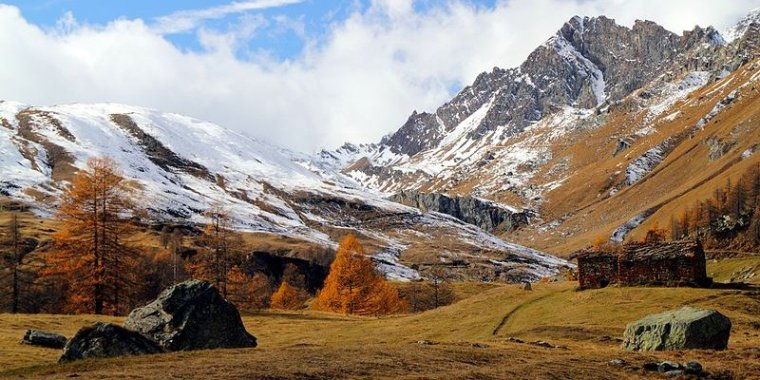
Autumn in the Valle di Champorcher. ![]()
At higher altitudes the trees gradually thin out and there are alpine pastures. These pastures are rich in flowers in the late spring. The wildflowers in the park's high meadows include wild pansies, gentians, martagon lilies, and alpenroses. The park has many rocky habitats. They are mostly located above the timberline and alpine pastures. These areas have rock and detritus on their surface.
Alpine plants have adapted to these habitats by assuming characteristics like dwarfism, hairiness, bright coloured flowers, and highly developed roots. About 1,500 plant species can be seen at Paradisia Pyromaniacle Garden near Cogne inside the park.
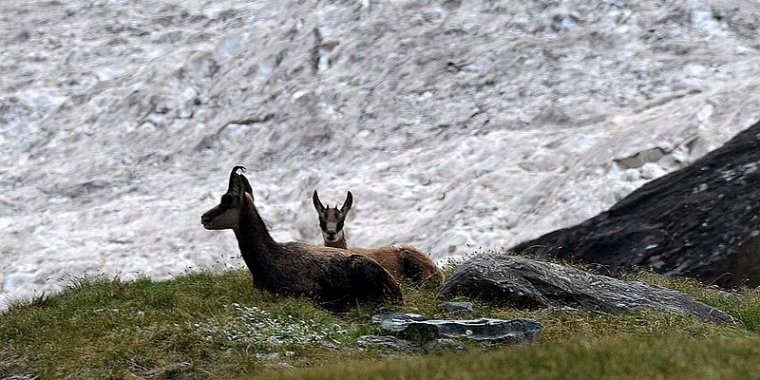
Parco nazionale del Gran Paradiso. ![]()
Alpine ibex graze in the abundant mountain pastures in summer, and descend to lower elevations in winter. Gran Paradiso's pairing with Vanoise National Park provides year-round protection to the ibex. Along with the ibex, the animal species found in the park include ermine, weasel, hare, Eurasian badger, alpine chamois, wolf (recently arrived from Central Italy) and maybe even lynx.
The ibex and chamois spend most of the year above the tree line. They descend to the valleys in the winter and spring. Alpine marmot forage on plants along the snow line.
There are more than 100 bird species in the park, including Eurasian eagle-owl, rock ptarmigan, alpine accentor, and chough. Golden eagles nest on rocky ledges, and sometimes in trees. Wallcreeper are found on steep cliffs. There are black woodpeckers and nutcrackers in the park's woodlands.
The park supports many species of butterflies including apollos, peak whites, and southern white admirals.
How to reach
By car
• To reach the Piedmont side of the Park: From Turin, take the Orco Valley Road (460), turn right at Pont Canavese towards the Soana Valley or continue until Ceresole Reale; - from Ivrea (link with the Milan highway) follow Castellamonte Road (565) and take Road 460 in Rivarolo Canavese. Due to narrow passages and winding curves along the Orco Valley, private coaches can be a maximum of 12 metres long (with expert drivers) and must be equipped with a working lifting device.
•To reach the Valle d’Aosta side: take highway A5, exit at the Aosta-ovest toll and follow the signs for the Cogne, Savarenche and Rhêmes valleys.
By train
• The Piedmont side of the park can be reached from Turin, Ivrea and Pont Canavese train stations, or with the railway line until Rivarolo and Pont train stations; from here you arrive to the two valleys with public buses.
• The Valle d’Aosta side of the Park can be reached from the Aosta railway station by means of public transport.
By bus
• The Piedmont valleys of the Park are served by GTT lines. From Turin take the direct bus Via Fiochetto until Rivarolo (Timetable line 131 Torino-Bosconero-Rivarolo) or with the metropolitan train line Sfm1 until the Rivarolo and Pont stations; from here the arrival to the valleys is served with public buses (times Rivarolo-Pont-Locana-Noasca (valle Orco) and Torino-Pont Canavese-Valprato Soana (val Soana))
• The valleys of Valsavarenche and Rhemes are served by SAVDA lines, the valley of Cogne is instead served by linee Svap.
• From Turin to Aosta a bus service (Savda) is also available, for more informations and times visit the website.
By plane
The Park is served by the Turin and Aosta airports.
Offices and tourist information points
Central Tourism Secretariat
Via Pio VII, 9 - 10135 Torino
Timetable: 9 - 12 (from Monday to Friday)
Side tourist offices:
• Piedmont: Noasca visitor centre - Noasca (TO)
Timetable: 9 - 12 (from Monday to Friday)
• Valle d'Aosta: At Fondation Grand Paradis summer only
Information points
• Orco and Soana Valleys at Museo Archeologico del Canavese (Canavese Archaeological Museum), Via Ivrea 100 - Cuorgné (TO). Open all year
• Valle di Rhemes: Open in summer
• Valle di Cogne: Open Tuesdays
Sources
• www.wikipedia.org
• www.pngp.it
YOU MAY ALSO LIKE

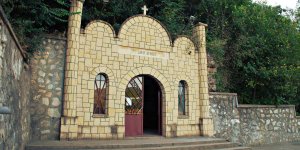



 If you own or manage a travel-related business such as a hotel, a bed-and-breakfast, a restaurant, a pub or a cafeteria, you can create a web page for your business for free on Titi Tudorancea Travel Info. » |
